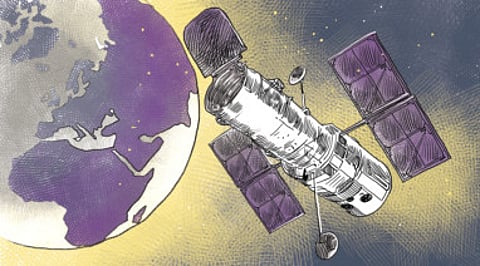Hubble telescope’s double achievement
Nebulas, galaxies and exoplanets have become like sunsets, waterfalls and misty mountains, drawing in the public’s mind a sense of utter beauty, wonder and awe, as well as a sense of mystery

Twenty-five years ago, on April 25, 1990, the Hubble Space Telescope (HST) was placed in orbit around Earth. Its accomplishments have been historic, both scientifically and culturally. Indeed, while HST was not the first satellite or space-based observer of the universe, it soon became the most important astronomical telescope ever built, and it struck the public’s attention and imagination like no other scientific project ever did.
Even before it saw the light (of the heavens), HST already had a long and rich history.
Indeed, it had been proposed almost 50 years before it was placed in orbit by the space shuttle. In the 1940s, scientists took note of the (then) burgeoning space rocket technology and stressed the huge scientific benefits of putting a telescope in space. Indeed, the Earth’s atmosphere has always constituted one of the main obstacles to clear and sharp observations of celestial objects, due to its constant turbulence, its absorption of light rays (particularly in the infra-red and ultra-violet bands), not to mention the cloudiness and other spoilers of astronomical exploration. Then, stressing the project’s high importance, HST was named after one of the greatest American astronomers, Edwin Hubble, who in the 1920s had, for the first time in human history, discovered other galaxies beyond the Milky Way, and followed it with the discovery of the expansion of the universe, which pointed to a beginning, a moment of creation. By the time it was placed in orbit, 570km above Earth’s surface, the space telescope had cost $1.5 billion (Dh5.5 billion), not counting the cost of the trip onboard the space shuttle or the follow-up servicing missions.
The story took an awful turn, however, when the HST sent its first images back to Earth, as it was realised that the instrument was myopic! Its mirror, with a diameter of 2.4 metres, had been wrongly curved, by just a millimetre, but enough to make the images fuzzy, ugly, and useless. The next few years were spent preparing a fix, quite literally “glasses” for our myopic robot, and adding a few devices, including a next-generation camera, to make Hubble even better than it was originally supposed to be.
The stage was then set for one of the greatest human adventures: a bus-size satellite that orbits the Earth every 97 minutes, looking outward from around Earth to planets, stars and galaxies, and the rest of the universe, exploring cosmic space and time, taking countless images and recording stunning data of incredible objects and phenomena, for days, months, and years. Through its achievements, the Hubble Space Telescope has had the double distinction of producing scientific results and discoveries of the highest order and of striking the public’s attention and appreciation. Some of its iconic images have taken root in our cultural consciousness, from postage stamps to theological discussions (are we alone in the universe?). For example, the Nasa historian Steven J. Dick wrote that “the famous Eagle Nebula with its ‘Pillars of Creation’… evoked an almost religious response in some people…” The cultural impact of Hubble has been unprecedented and momentous.
Universe in accelerated mode
The HST is one rare instance of the public not asking “why are we spending money on that?”, even though it realises that no practical benefit comes from the project. In fact, when in 2004 the Nasa chief administrator decided to stop servicing the HST, there was such a public outcry that the decision was reversed!
Scientifically, the HST has made numerous ground-breaking discoveries, from our neighbourhood to the universe at large, making it one of the prime contributors to astronomy each year. To name just a few noteworthy findings: in 1994 HST provided detailed and instant-by-instant photographs of the collision of Comet Shoemaker-Levy 9 with Jupiter, the first time humans had observed such a cosmic event; in 1998 Hubble stunned the scientific community by discovering that the universe is not only in expansion but in fact in an accelerated mode; a decade ago, it imaged cocoons of solar systems in the making; and most recently, it photographed planets around faraway stars and even detected in some of their atmospheres water vapour and molecules that could perhaps constitute the building blocks or the signatures of life underneath.
The Hubble Space Telescope has indeed performed an extraordinary feat: making historic discovery after another and providing a wealth of data for scientists to dissect, while at the same time bringing the universe to our eyes and minds, making us feel closely connected and part of the cosmic saga that has been unfolding so beautifully since the Big Bang.
Nebulas, galaxies, and exoplanets have become like sunsets, waterfalls and misty mountains, drawing in the public’s mind a sense of utter beauty, wonder and awe, as well as a sense of mystery, excitement, connectedness, and even spirituality.
Science, even at the frontiers of research, does not have to be obscure, dull, or elitist. Cosmic exploration can be beautiful, exciting, stunning, perplexing, attractive, and jaw-dropping. Most of all, it can lift our spirits. Hubble has done that.
Nidhal Guessoum is a professor of physics and astronomy at the American University of Sharjah. You can follow him on Twitter at: www.twitter.com/@NidhalGuessoum.
Sign up for the Daily Briefing
Get the latest news and updates straight to your inbox



